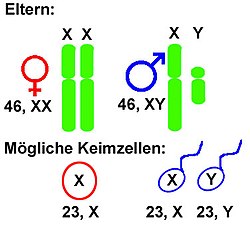
Back صبغي جنسي Arabic Ганасомы Byelorussian Ганасомы BE-X-OLD লিঙ্গ ক্রোমোজোম Bengali/Bangla Spolni hromosom BS Al·losoma Catalan توخمی کرۆمۆسۆم CKB Pohlavní chromozom Czech Kønskromosom Danish Gonosom German

As Gschlächtschromosoom oder Gonosoom (mänggisch au Heterochromosoom, Heterosoom oder Allosoom) bezäichnet mä Chromosoom, wo dr Karyotyp von ene s genetische Gschlächt vom ene Individuum bestimmt.
D Autosoome, das si Chromosoom, wo s Gschlächt nid beiiflusse, git s in diploide Zälle as Bäärli vo Chromosoome, wo fast idäntisch, d. h. homolog si. In äim vo de Gschlächter si aber d Gschlächtschromosoome käi homologs Bäärli, sondern si underschäide sich dütlig in ihrem Inhalt und hüfig au in ihrer Gröössi. S menschlige Y-Chromosoom zum Bischbil isch dütlig chliiner as s X-Chromosoom, bim Wiisse Liechtnäägeli isch aber s Y-Chromosoom dütlig gröösser.
Wenn s Gschlächt chromosomal bestimmt wird, wird s noch de Mendelsche Regle vererbt. Die Form vo dr Gschlächtsbestimmig isch im Lauf vo dr Evoluzioon bi verschidnige Artegrubbe unabhängig vonenander entstande und chunnt zum Bischbil bi Süüger, Vögel und e baar Insekte[1], aber au in Gfäässpflanze voor. Bi andere Arte wird s Gschlächt hingeege dur Umwältbedingige festgläit, z. B. dur d Tämpratur bi dr Embryonalentwicklig.
Mä underschäidet bi Gschlächtschromosoom verschidnigi System: s XX/XY-System (bi Süüger und eso bim Mensch, gwüsse Insekte-, Reptilie-, Amfibie-, Fisch- und Pflanzearte), s ZW/ZZ-System (bi Vöögel, de mäiste Schlange, e baar Fisch- und Insektearte) und s XX/X0-System (z. B. bi Nematode).
- ↑ Panagiota Manolakou, Giagkos Lavranos and Roxani Angelopoulou. Molecular patterns of sex determination in the animal kingdom: a comparative study of the biology of reproduction. 2006. Reproductive Biology and Endocrinology, 4:59. doi:10.1186/1477-7827-4-59